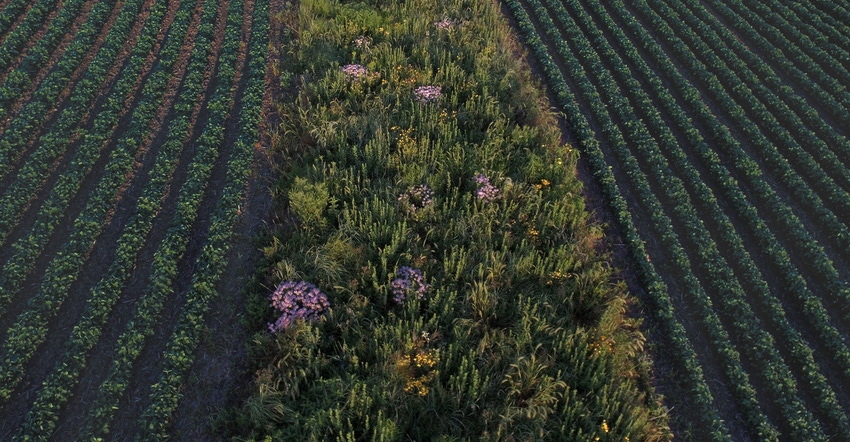January 16, 2020

The 2018 Farm Bill, approved by Congress and signed into law late in 2018, for the first time named prairie strips, the strategic planting of small amounts of prairie within corn and soybean fields, as a conservation practice eligible to participate in the Conservation Reserve Program. New signups for CRP opened in early.
CRP gives farmers a yearly rental payment for converting environmentally sensitive land from production and establishing conservation practices on that land. Prairie strips are now an official practice under the CRP Clean Lakes, Estuaries and Rivers Initiative.
When developing policy to implement the law, USDA sought input from ISU researchers who pioneered much of the science on prairie strips over the last decade.
Clarifying the rules, priorities
Omar de Kok-Mercado, program coordinator in natural resource ecology and management for the Science-based Trials of Rowcrops Integrated with Prairie Strips team at ISU, coordinated the STRIPS team’s efforts to develop technical specifications for the prairie strips policy and submitted the work to USDA. The new policy has been approved by USDA. Farmers can offer to apply prairie strips through the ongoing Continuous CRP sign-up at their local USDA Service Center.
ISU’s contribution to the CRP policy development process required translating experimental findings into real-world management guidelines that can be understood by farmers and implemented by policymakers. The new rules specific to prairie strips will provide greater clarity, flexibility and reliability for farmers who want to implement the practice, says de Kok-Mercado.
Lisa Schulte Moore, ISU professor of natural resource ecology and management on the STRIPS team, has heard from many farmers eager to take advantage of the new rule. “The 2018 Farm Bill sent a clear signal from Congress and the White House that this is the direction we want our farm conservation programs to go,” she says. “We’ve heard from farmers who’ve been waiting so they can sign up portions of their fields for prairie strips. With last year’s heavy rain events, they are looking for good options to both slow erosion and deal with challenging acres.”
Strips provide various benefits
ISU scientists began conducting research on prairie strips more than 10 years ago. Since then, they’ve documented a range of environmental benefits associated with the practice. Prairie strips reduce soil and nutrient loss from steep ground, provide habitat for wildlife and improve water infiltration.
According to a 2017 ISU study, converting as little as 10% of the cropped area to prairie conservation strips reduced soil loss by 95%, phosphorus losses in surface runoff by 77%, nitrate concentrations in groundwater by 72% and total nitrogen losses in surface runoff by 70%, compared with all-crop watersheds. Pollinator and bird abundance more than doubled.
STRIPS research has been funded by multiple organizations, including USDA Farm Service Agency, U.S. Forest Service and National Institute for Food & Agriculture. “As a scientist, it’s satisfying to be a part of the whole process,” says Schulte Moore. “Our USDA-funded research is now being used to improve USDA programming for people and the land.”
Most conservation practices aim for a single measurable benefit, but ISU experiments have shown that prairie strips address a range of concerns. Schulte Moore says prairie strips also are among the least expensive conservation practices on a per-acre basis. Visit your local USDA service center to learn more about CRP and prairie strips.
Source: ISU, which is solely responsible for the information provided and is wholly owned by the source. Informa Business Media and all its subsidiaries are not responsible for any of the content contained in this information asset.
You May Also Like




